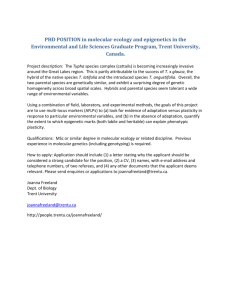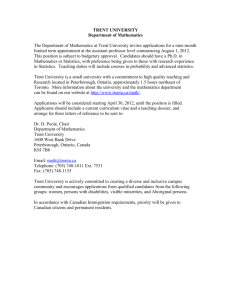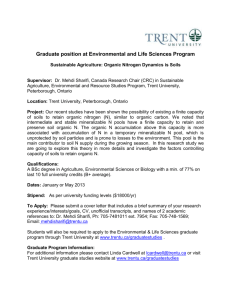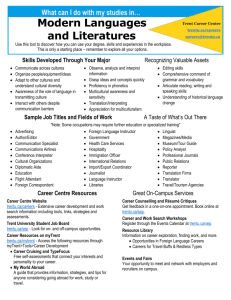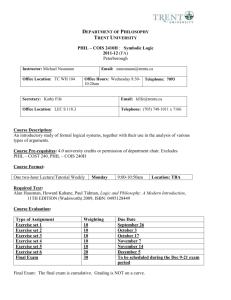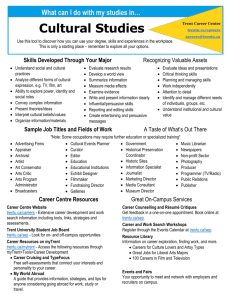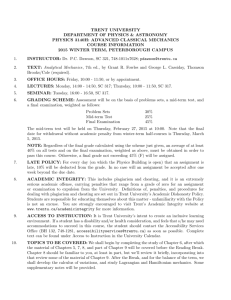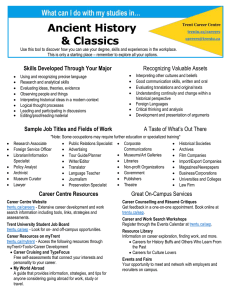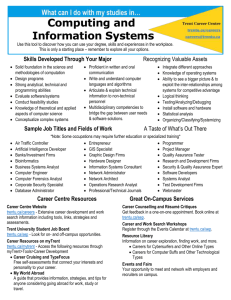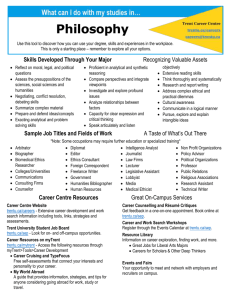ENVIRONMENTAL AND RESOURCE SCIENCE/STUDIES ERSC
advertisement
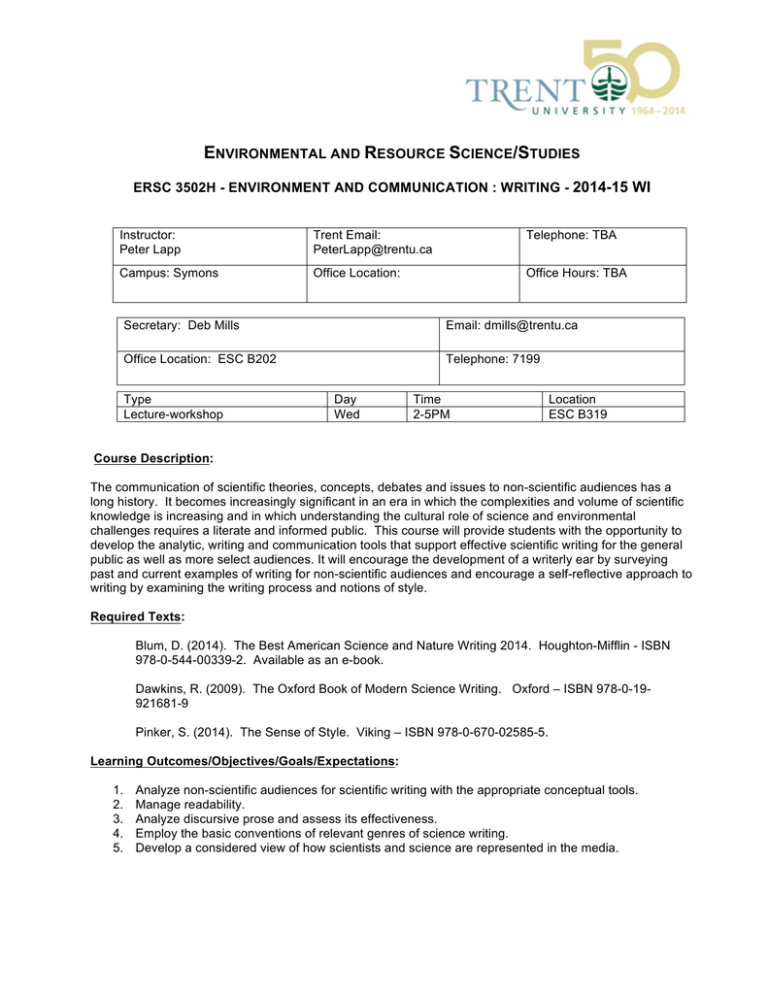
ENVIRONMENTAL AND RESOURCE SCIENCE/STUDIES ERSC 3502H - ENVIRONMENT AND COMMUNICATION : WRITING - 2014-15 WI Instructor: Peter Lapp Trent Email: PeterLapp@trentu.ca Telephone: TBA Campus: Symons Office Location: Office Hours: TBA Secretary: Deb Mills Email: dmills@trentu.ca Office Location: ESC B202 Telephone: 7199 Type Lecture-workshop Day Wed Time 2-5PM Location ESC B319 Course Description: The communication of scientific theories, concepts, debates and issues to non-scientific audiences has a long history. It becomes increasingly significant in an era in which the complexities and volume of scientific knowledge is increasing and in which understanding the cultural role of science and environmental challenges requires a literate and informed public. This course will provide students with the opportunity to develop the analytic, writing and communication tools that support effective scientific writing for the general public as well as more select audiences. It will encourage the development of a writerly ear by surveying past and current examples of writing for non-scientific audiences and encourage a self-reflective approach to writing by examining the writing process and notions of style. Required Texts: Blum, D. (2014). The Best American Science and Nature Writing 2014. Houghton-Mifflin - ISBN 978-0-544-00339-2. Available as an e-book. Dawkins, R. (2009). The Oxford Book of Modern Science Writing. Oxford – ISBN 978-0-19921681-9 Pinker, S. (2014). The Sense of Style. Viking – ISBN 978-0-670-02585-5. Learning Outcomes/Objectives/Goals/Expectations: 1. 2. 3. 4. 5. Analyze non-scientific audiences for scientific writing with the appropriate conceptual tools. Manage readability. Analyze discursive prose and assess its effectiveness. Employ the basic conventions of relevant genres of science writing. Develop a considered view of how scientists and science are represented in the media. Type of Assignment Attendance, readings, participation Journal Interview Script and reading (group) Article Presentation of article Weighting 10% 10% 25% 15% 30% 10% Due Date Ongoing Wk 6 Wks 7&9 Wks 7-9 Wks 10&12 To be scheduled Wks 2-8 Explanation of assignments and marking: Journal: a weekly comment on the “take-away” from presentations and discussions of scientific writing for a non-scientific audience. Assessed in terms of consistent entries, quality of style, and level of insight. Interview: a magazine/newspaper article based on interviewing a scientist and presenting them and their work to a non-scientific audience. Assessed for appreciation of audience, format, writerly skills, and challenge of material. Article: a magazine format article presenting a scientific issue or development and targeted to a specific publication. Assessed for appreciation of the publication, its audience, writerly skills, and challenge of material. Presentation of article: a presentation of a reading from one of the two collections of scientific writing. To focus on the writer, the nature of the original publication, the perceived strengths and shortcomings of the reading, and the “take-away” for the presenter and the class. Week-by-week schedule: Wk - Date 1 - Jan 7 2 - Jan 14 3 - Jan 21 4 - Jan 28 5 - Feb 4 6 - Feb 11 7 8 - Feb 25 9 - Mar 4 10 - Mar 11 11 – Mar 18 12 – Mar 25 13 – Apr 1 Lecture/workshop NOTE - Main Pinker weekly readings are provided below – selections from Blum and Dawkins will be developed with students and announced in a timely fashion. Additional materials are supplied at the instructor’s discretion. Introduction, communication, basics - Words in action Scientific communication, writing and genres 1 - Sentence-level readability Read – Pinker all Chpt 1 and Chpt 4 selections Scientific communication, writing and genres 2 - Disciplinary discourse bubbles and abstractions Read – Pinker Chpt 2 Mass media and communication issues - A cognitive view of grammar Read - Pinker Chpt 6 selections overview Magazines – hard-copy and e’ - Review of article formats and assignment st Reviewing and Tying up the 1 half Reading Break Into the Pop’ world – TV, movies and novels: good, bad and ugly - Narrative techniques and dialogue Reversing field - popularizing science from Hawthorne to London - Narrative techniques, controlling audience sympathy and identification - Presenting the “scenes” The state of the internet - Audience, genre, style, medium The political climate and commentary - The views from left and right and Lakoff; tuning prose An omnibus of case studies Reviewing and tying up the term - Presenting interviews 2 University Policies Academic Integrity: Academic dishonesty, which includes plagiarism and cheating, is an extremely serious academic offence and carries penalties varying from failure on an assignment to expulsion from the University. Definitions, penalties, and procedures for dealing with plagiarism and cheating are set out in Trent University’s Academic Integrity Policy. You have a responsibility to educate yourself – unfamiliarity with the policy is not an excuse. You are strongly encouraged to visit Trent’s Academic Integrity website to learn more: www.trentu.ca/academicintegrity. Access to Instruction: It is Trent University's intent to create an inclusive learning environment. If a student has a disability and/or health consideration and feels that he/she may need accommodations to succeed in this course, the student should contact the Student Accessibility Services Office (SAS), (BH Suite 132, 705-748-1281 or email accessibilityservices@trentu.ca). For Trent University - Oshawa Student Accessibility Services Office contact 905-435-5102 ext. 5024 or email nancyhempel@trentu.ca . Complete text can be found under Access to Instruction in the Academic Calendar. 3
